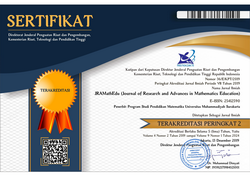A factor analytic structure of the conceptions of mathematics scale among pre-service mathematics teachers in South-West Nigeria
Adeneye Olarewaju Awofala(1*), Abisola Olusola Lawani(2), Chidinma O. Oraegbunam(3)(1) Department of Science and Technology Education, Faculty of Education, University of Lagos
(2) Department of Mathematics, College of Science and Information Technology, Tai Solarin University of Education, Nigeria
(3) Department of Science and Technology Education, Faculty of Education, University of Lagos
(*) Corresponding Author
Abstract
An exploration of factor analytic structure of the conceptions of mathematics scale among pre-service mathematics teachers in South-West Nigeria was conducted as evidence suggests paucity of research on psychometric properties of the conceptions of mathematics scale in Nigeria.This article through instrumentation research methodology reports the reliability and validity of the Conceptions of Mathematics Scale based on the responses of 228 pre-service mathematics teachers from five public universities in South-West Nigeria. The reliability assessed as internal consistency produced a Cronbach alpha of .88. A principal components exploration with varimax gyration established the validity of the scale as two-component archetypal accounting for 48.9% of the total variance. The dimensions were taken as Patchy Formations and Unified Formations of mathematics, as explicated in the original and other replicating studies. The factor solution could be compared to that recounted in the previous studies; hence the outcome showed the need to adopt the scale in the Nigerian context, as the pedagogy implemented during the teaching and learning of mathematics can influence students’ conceptions of mathematics. Thus, teaching mathematics with rules-based and algorithm-dependent teacher-centered pedagogies might result into rote memorization thereby leading to patchy formations while teaching mathematics as a meaningful subject full of applications to the real life could engender conceptual understanding leading to unified formations. The implication of this study is that students with patchy formation are connected with surface approaches to learning while those with unified formation of mathematics are connected with deep approaches to learning and engaging mathematics.
Keywords
Full Text:
PDFReferences
Akinsola, M. K., & Awofala, A. O. A. (2008). Effects of problem context and reasoning complexity on mathematics problem solving achievement and transfer of secondary school students. European Journal of Scientific Research, 20(3), 641–651.
Alkhateeb, H. M. (2001). University students' conceptions of first-year mathematics. Psychological Reports, 89, 41- 47. https://doi.org/10.2466/pr0.2001.89.1.41.
Alt, D. & Boniel-Nissim, M. (2018). Links between Adolescents' Deep and Surface Learning Approaches, Problematic Internet Use, and Fear of Missing Out (FoMO). Internet Interventions, 13, 30-39. https://doi.org/10.1016/j.invent.2018.05.002
Awofala, A. O. A. (2011). Effect of personalized, computer-based instruction on students’ achievement in solving two-step word problems. International Journal of Mathematics Trends and Technology. 2(2), 5-10.http://www.ijmttjournal.org/Volume-2/issue-2/IJMTT-V2I2P502.pdf
Awofala, A. O. A. (2012). An analysis of the new 9-year basic education mathematics curriculum in Nigeria in the new millennium. Acta Didactica Napocensia, 5(1), 156-170. https://eric.ed.gov/?id=EJ1054294
Awofala, A. O. A. (2016). Examining preservice mathematics teachers’ attitudes toward mathematics. Nigerian Journal of Curriculum Studies, 23, 292-300.
Awofala, A. O. A. & Awolola, S. A. (2011).Curriculum value orientation and reform in the 9-year basic education mathematics curriculum. In O.S. Abonyi (Ed.) Proceedings of 52nd Annual Conference of the Science Teachers Association of Nigeria on Reforms in Science, Technology, Engineering and Mathematics( pp.297-303) HEBN Publishers Plc.
Awofala, A. O. A, Ola-Oluwa, S. A. & Fatade, A. O. (2012). Teachers’ perception of the new nine-year basic education mathematics curriculum in Nigeria. International Journal of Mathematics Trends and Technology, 3(1), 1-6. http://www.ijmttjournal.org/Volume-3/issue-1/IJMTT-V3I1P501.pdf
Bonsaksen, T., Brown, T., Lim, H. B. & Fong, K. (2017). Approaches to studying predict academic performance in undergraduate occupational therapy students: a cross-cultural study. BMC Medical Education, 17(1), 76. https://doi.org/10.1186/s12909-017-0914-3
Bonsaksen, T. (2018). Deep, surface, or both? A study of occupational therapy students’ learning concepts. Occupational Therapy International, 1-8. https://doi.org/10.1155/2018/3439815
Carstensen, T., Ødegaard, N. B. &Bonsaksen, T. (2018). Approaches to studying: associations with learning conceptions and preferences for teaching. Cogent Education, 5(1), 1–11. https://doi.org/10.1080/2331186X.2018.1480909
Cattell, R. B. (1966). The scree test for the number of factors. Multivariate Behavioral Research, 1, 245-276.https://doi.org/10.1207/s15327906mbr0102_10
Crawford, K. (1992). Cultural processes and learning: exectations, actions and outcomes [paper presentation]. The International Congress on Mathematics Education, Quebec, City, Canada, August.
Crawford, K., Gordon, S., Nicholas, J., & Prosser, M. (1994). Conceptions of mathematics and how it is learned: the perspectives of students entering university. Learning and Instruction, 4 , 331 -345. https://doi.org/10.1016/0959-4752(94)90005-1
Crawford, K., Gordon, S., Nicholas, J., & Prosser, M. (1998a). Qualitatively different experiences of learning mathematics at university. Learning and Instruction, 8, 455 - 468. https://doi.org/10.1016/S0959-4752(98)00005-X
Crawford, K., Gordon, S., Nicholas, J., & Prosser, M. (1998b). University mathematics students' conceptions of mathematics. Studies in Higher Education, 23, 87 - 94. https://doi.org/10.1080/03075079812331380512
Erdem, E., & Gürbüz, R. (2015). An analysis of seventh-grade students’ mathematical reasoning. Cukurova University Faculty of Education Journal, 45(1), 123-142. https://dergipark.org.tr/en/pub/cuefd/issue/4139/54361
Hair Jr., J. F., Black, W. C., Babin, . J. & Anderson, R. E. (2009). Multivariate data analysis. Seventh Edition. Pearson Education Limited.
Horn, J. L. (1965). A rationale and test for the number of factors in factor analysis. Psychometrika, 30, 179-185. https://doi.org/10.1007/BF02289447
Kaiser, H. F. (1960). The application of electronic computers to factor analysis. Educational and Psychological Measurement, 20(1), 141 - 151. https://doi.org/10.1177%2F001316446002000116
Mji, A. (1999). Reliability and validity of the conceptions of mathematics questionnaire. Psychological Reports, 85(2), 579 - 582. https://doi.org/10.2466%2Fpr0.1999.85.2.579
Mji, A., & Arigbabu, A. A. (2012). Relationship between and among preservice mathematics teachers' conceptions, efficacy beliefs and anxiety. International Journal of Education Science, 4(3), 261 - 270. https://doi.org/10.1080/09751122.2012.11890051
Monroy, F. & González-Geraldo, J. L. (2018). Measuring learning: discrepancies between conceptions of and approaches to learning. Educational Studies, 44(1), 81–98.
Nigerian Educational and Research and Development Council. (NERDC, 2013). 9-year Basic Education Curriculum, Mathematics for Upper Basic Education. Lagos: NERDC Press. http://www.nerdc.org.ng/eCurriculum/CurriculumStructure.aspx.
Tabachnick, B. G. & Fidell, L. S. (2007). Using multivariate statistics (5th Ed.). Boston, MA, Allyn & Bacon.
Article Metrics
Abstract view(s): 545 time(s)PDF: 426 time(s)
Refbacks
- There are currently no refbacks.







